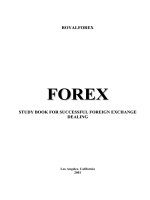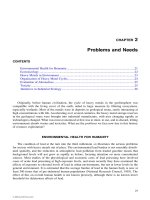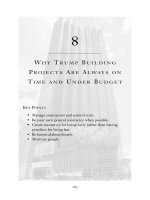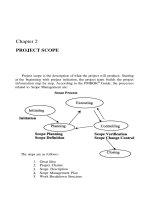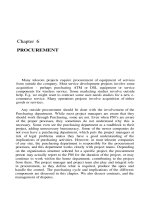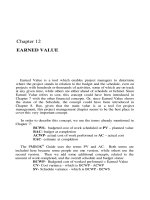Forex On-Line Manual For Successful Trading Chapter 2 ppsx
Bạn đang xem bản rút gọn của tài liệu. Xem và tải ngay bản đầy đủ của tài liệu tại đây (57.79 KB, 8 trang )
FOREX. On-line Manual For Successful Trading 15
CHAPTER 2
Kinds Of Major Currencies
And Exchange Systems
2.1. Major Currencies
The U.S. Dollar
The United States dollar is the world's main currency. All currencies are
generally quoted in U.S. dollar terms. Under conditions of international economic
and political unrest, the U.S. dollar is the main safe-haven currency which was
proven particularly well during the Southeast Asian crisis of 1997-1998.
The U.S. dollar became the leading currency toward the end of the
Second World War and was at the center of the Bretton Woods Accord, as the
other currencies were virtually pegged against it. The introduction of the euro in
1999 reduced the dollar's importance only marginally.
The major currencies traded against the U.S. dollar are the euro,
Japanese yen, British pound, and Swiss franc.
The Euro
The euro was designed to become the premier currency in trading by
simply being quoted in American terms. Like the U.S. dollar, the euro has a
strong international presence stemming from members of the European
Monetary Union. The currency remains plagued by unequal growth, high
unemployment, and government resistance to structural changes. The pair was
also weighed in 1999 and 2000 by outflows from foreign investors, particularly
Japanese, who were forced to liquidate their losing investments in euro-
denominated assets. Moreover, European money managers rebalanced their
portfolios and reduced their euro exposure as their needs for hedging currency
risk in Europe declined.
FOREX. On-line Manual For Successful Trading 16
The Japanese Yen
The Japanese yen is the third most traded currency in the world; it has a
much smaller international presence than the U.S. dollar or the euro. The yen is
very liquid around the world, practically around the clock. The natural demand to
trade the yen concentrated mostly among the Japanese keiretsu, the economic
and financial conglomerates.
The yen is much more sensitive to the fortunes of the Nikkei index, the
Japanese stock market, and the real estate market. The attempt of the Bank of
Japan to deflate the double bubble in these two markets had a negative effect
on the Japanese yen, although the impact was short-lived
The British Pound
Until the end of World War II, the pound was the currency of reference. Its
nickname, cable, is derived from the telex machine, which was used to trade it
in its heyday. The currency is heavily traded against the euro and the U.S.
dollar, but has a spotty presence against other currencies. The two-year bout
with the Exchange Rate Mechanism, between 1990 and 1992, had a soothing
effect on the British pound, as it generally had to follow the deutsche mark's
fluctuations, but the crisis conditions that precipitated the pound's withdrawal from
the ERM had a psychological effect on the currency.
Prior to the introduction of the euro, both the pound benefited from any
doubts about the currency convergence. After the introduction of the euro, Bank
of England is attempting to bring the high U.K. rates closer to the lower rates in
the euro zone. The pound could join the euro in the early 2000s, provided that
the U.K. referendum is positive.
The Swiss Franc
The Swiss franc is the only currency of a major European country that
belongs neither to the European Monetary Union nor to the G-7 countries.
Although the Swiss economy is relatively small, the Swiss franc is one of the
four major currencies, closely resembling the strength and quality of the Swiss
economy and finance. Switzerland has a very close economic relationship with
Germany, and thus to the euro zone. Therefore, in terms of political uncertainty
in the East, the Swiss franc is favored generally over the euro.
Typically, it is believed that the Swiss franc is a stable currency.
Actually, from a foreign exchange point of view, the Swiss franc closely
resembles the patterns of the euro, but lacks its liquidity. As the demand for it
exceeds supply, the Swiss franc can be more volatile than the euro.
FOREX. On-line Manual For Successful Trading 17
2.2. Kinds of Exchange Systems
Trading with Brokers
Foreign exchange brokers, unlike equity brokers, do not take positions for
themselves; they only service banks. Their roles are:
• bringing together buyers and sellers in the market;
• optimizing the price they show to their customers;
• quickly, accurately, and faithfully executing the traders' orders.
The majority of the foreign exchange brokers execute business via phone.
The phone lines between brokers and banks are dedicated, or direct, and are
usually in-stalled free of charge by the broker. A foreign exchange brokerage
firm has direct lines to banks around the world. Most foreign exchange is
executed through an open box system—a microphone in front of the broker that
continuously transmits everything he or she says on the direct phone lines to the
speaker boxes in the banks. This way, all banks can hear all the deals being
executed. Because of the open box system used by brokers, a trader is able to
hear all prices quoted; whether the bid was hit or the offer taken; and the
following price. What the trader will not be able to hear is the amounts of
particular bids and offers and the names of the banks showing the prices. Prices
are anonymous the anonymity of the banks that are trading in the market ensures
the market's efficiency, as all banks have a fair chance to trade.
Brokers charge a commission that is paid equally by the buyer and the
seller. The fees are negotiated on an individual basis by the bank and the
brokerage firm.
Brokers show their customers the prices made by other customers either
two-way (bid and offer) prices or one way (bid or offer) prices from his or her
customers. Traders show different prices because they "read" the market
differently; they have different expectations and different interests. A broker who
has more than one price on one or both sides will automatically optimize the
price. In other words, the broker will always show the highest bid and the
lowest offer. Therefore, the market has access to the narrowest spread possible.
Fundamental and technical analyses are used for forecasting the future direction
of the currency. A trader might test the market by hitting a bid for a small
amount to see if there is any reaction.
Brokers cannot be forced into taking a principal's role if the name switch
takes longer than anticipated.
Another advantage of the brokers' market is that brokers might provide a
broader selection of banks to their customers. Some European and Asian banks
have overnight desks so their orders are usually placed with brokers who can deal
with the American banks, adding to the liquidity of the market.
FOREX. On-line Manual For Successful Trading 18
Direct Dealing
Direct dealing is based on trading reciprocity. A market maker—the bank
making or quoting a price—expects the bank that is calling to reciprocate with
respect to making a price when called upon. Direct dealing provides more trading
discretion, as compared to dealing in the brokers' market. Sometimes traders take
advantage of this characteristic.
Direct dealing used to be conducted mostly on the phone. Dealing errors
were difficult to prove and even more difficult to settle. In order to increase
dealing safety, most banks tapped the phone lines on which trading was
conducted. This measure was helpful in recording all the transaction details and
enabling the dealers to allocate the responsibility for errors fairly. But tape
recorders were unable to prevent trading errors. Direct dealing was forever
changed in the mid - 1980s, by the introduction of dealing systems.
Dealing Systems
Dealing systems are on-line computers that link the contributing banks
around the world on a one-on-one basis. The performance of dealing systems is
characterized by speed, reliability, and safety. Accessing a bank through a dealing
system is much faster than making a phone call. Dealing systems are
continuously being improved in order to offer maximum support to the dealer's
main function: trading. The software is very reliable in picking up the big figure of
the exchange rates and the standard value dates. In addition, it is extremely
precise and fast in contacting other parties, switching among conversations, and
accessing the database. The trader is in continuous visual contact with the
information exchanged on the monitor. It is easier to see than hear this
information, especially when switching among conversations.
Most banks use a combination of brokers and direct dealing systems. Both
approaches reach the same banks, but not the same parties, because
corporations, for instance, cannot deal in the brokers' market. Traders develop
personal relationships with both brokers and traders in the markets, but select
their trading medium based on price quality, not on personal feelings. The market
share between dealing systems and brokers fluctuates based on market
conditions. Fast market conditions are beneficial to dealing systems, whereas
regular market conditions are more beneficial to brokers.
Matching Systems
Unlike dealing systems, on which trading is not anonymous and is
conducted on a one-on-one basis, matching systems are anonymous and
individual traders deal against the rest of the market, similar to dealing in the
brokers' market. However, unlike the brokers' market, there are no individuals
to bring the prices to the market, and liquidity may be limited at times. Matching
systems are well-suited for trading smaller amounts as well.
The dealing systems characteristics of speed, reliability, and safety are
replicated in the matching systems. In addition, credit lines are automatically
FOREX. On-line Manual For Successful Trading 19
managed by the systems. Traders input the total credit line for each counter
party. When the credit line has been reached, the system automatically disallows
dealing with the particular party by displaying credit restrictions, or shows the
trader only the price made by banks that have open lines of credit. As soon as
the credit line is restored, the system allows the bank to deal again. In the
interbank market, traders deal directly with dealing systems, matching systems,
and brokers in a complementary fashion.
FOREX. On-line Manual For Successful Trading 20
2.3. The Federal Reserve System of the USA and
Central Banks of the Other G-7 Countries
The Federal Reserve System of the USA
Like the other central banks, the Federal Reserve of the USA affects the
foreign exchange markets in three general areas:
• the discount rate;
• the money market instruments;
• foreign exchange operations.
For the foreign exchange operations most significant are repurchase
agreements to sell the same security back at the same price at a predetermined
date in the future (usually within 15 days), and at a specific rate of interest. This
arrangement amounts to a temporary injection of reserves into the banking
system. The impact on the foreign exchange market is that the dollar should
weaken. The repurchase agreements may be either customer repos or system
repos.
Matched sale-purchase agreements are just the opposite of repurchase
agreements. When executing a matched sale-purchase agreement, the Fed sells
a security for immediate delivery to a dealer or a foreign central bank, with the
agreement to buy back the same security at the same price at a predetermined
time in the future (generally within 7 days). This arrangement amounts to a
temporary drain of reserves. The impact on the foreign exchange market is that
the dollar should strengthen.
The major central banks are involved in foreign exchange operations in
more ways than intervening in the open market. Their operations include payments
among central banks or to international agencies. In addition, the Federal Reserve
has entered a series of currency swap arrangements with other central banks since
1962. For instance, to help the allied war effort against Iraq's invasion of Kuwait in
1990-1991, payments were executed by the Bundesbank and Bank of Japan to the
Federal Reserve. Also, payments to the World bank or the United Nations are executed
through central banks.
Intervention in the United States foreign exchange markets by the U.S.
Treasury and the Federal Reserve is geared toward restoring orderly conditions
in the market or influencing the exchange rates. It is not geared toward
affecting the reserves.
There are two types of foreign exchange interventions: naked intervention
and sterilized intervention.
Naked intervention, or unsterilized intervention, refers to the sole foreign
exchange activity. All that takes place is the intervention itself, in which the
FOREX. On-line Manual For Successful Trading 21
Federal Reserve either buys or sells U.S. dollars against a foreign currency. In
addition to the impact on the foreign exchange market, there is also a monetary
effect on the money supply. If the money supply is impacted, then consequent
adjustments must be made in interest rates, in prices, and at all levels of the
economy. Therefore, a naked foreign exchange intervention has a long-term
effect.
Sterilized intervention neutralizes its impact on the money supply. As there
are rather few central banks that want the impact of their intervention in the
foreign exchange markets to affect all corners of their economy, sterilized
interventions have been the tool of choice. This holds true for the Federal
Reserve as well.
The sterilized intervention involves an additional step to the original
currency transaction. This step consists of a sale of government securities that
offsets the reserve addition that occurs due to the intervention. It may be easier
to visualize it if you think that the central bank will finance the sale of a currency
through the sale of a number of government securities.
Because a sterilized intervention only generates an impact on the supply
and demand of a certain currency, its impact will tend to have a short-to
medium-term effect.
The Central Banks of the Other G-7 Countries
In the wake of World War II, both Germany and Japan were helped to
develop new financial systems. Both countries created central banks that were
fundamentally similar to the Federal Reserve. Along the line, their scope was
customized to their domestic needs and they diverged from their model.
The European Central Bank was set up on June 1, 1998 to oversee the
ascent of the euro. During the transition to the third stage of economic and
monetary union (introduction of the single currency on January 1, 1999), it was
responsible for carrying out the Community's monetary policy. The ECB, which
is an independent entity, supervises the activity of individual member European
central banks, such as Deutsche Bundesbank, Banque de France, and Ufficio
Italiano dei Cambi. The ECB's decision-making bodies run a European System of
Central Banks whose task is to manage the money in circulation, conduct
foreign exchange operations, hold and manage the Member States' official foreign
reserves, and promote the smooth operation of payment systems. The ECB is
the successor to the European Monetary Institute (EMI).
The German central bank, widely known as the Bundesbank, was the
model for the ECB. The Bundesbank was a very independent entity, dedicated to
a stable currency, low inflation, and a controlled money supply. The
hyperinflation that developed in Germany after World War I created a fertile
economic and political scenario for the rise of an extremist political party and for
FOREX. On-line Manual For Successful Trading 22
the start of World War II. The Bundesbank's chapter obligated it to avoid any such
economic chaos.
The Bank of Japan has deviated from the Federal Reserve model in terms
of independence. Although its Policy Board is still fully in charge of monetary
policy, changes are still subject to the approval of the Ministry of Finance
(MOF). The BOJ targets the M2 aggregate. On a quarterly basis, the BOJ
releases its Tankan economic survey. Tankan is the Japanese equivalent of the
American tan book, which presents the state of the economy. The Tankan's
findings are not automatic triggers of monetary policy changes. Generally, the
lack of independence of a central bank signals inflation. This is not the case in
Japan, and it is yet another example of how different fiscal or economic policies
can have opposite effects in separate environments.
The Bank of England may be characterized as a less independent central
bank, because the government may overrule its decision. The BOE has not had an
easy tenure. Despite the fact that British inflation was high through 1991, reaching
double-digit rates in the late 1980s, the Bank of England did a marvelous job of
proving to the world that it was able to maneuver the pound into mirroring the
Exchange Rate Mechanism.
After joining the ERM late in 1990, the BOE was instrumental in keeping
the pound within its 6 percent allowed range against the deutsche mark, but the
pound had a short stay in the Exchange Rate Mechanism. The divergence
between the artificially high interest rates linked to ERM commitments and
Britain's weak domestic economy triggered a massive sell-off of the pound in
September 1992.
The Bank of France has joint responsibility, with the Ministry of Finance, to
conduct domestic monetary policy. Their main goals are non-inflationary growth
and external account equilibrium. France has become a major player in the
foreign exchange markets since the ravages of the ERM crisis of July 1993, when
the French franc fell victim to the foreign exchange markets.
The Bank of Italy is in charge of the monetary policy, financial
intermediaries, and foreign exchange. Like the other former European
Monetary System central banks, BOI's responsibilities shifted domestically
following the ERM crisis. Along with the Bundesbank and Bank of France, the Bank
of Italy is now part of the European System of Central Banks (ESCB).
The Bank of Canada is an independent central bank that has a tight rein on
its currency. Due to its complex economic relations with the United States, the
Canadian dollar has a strong connection to the U.S. dollar. The BOC intervenes
more frequently than the other G7 central banks to shore up the fluctuations of
its Canadian dollar. The central bank changed its intervention policy in 1999 after
admitting that its previous mechanical policy, of intervening in increments of
only $50 million at a set price based on the previous closing, was not working.
